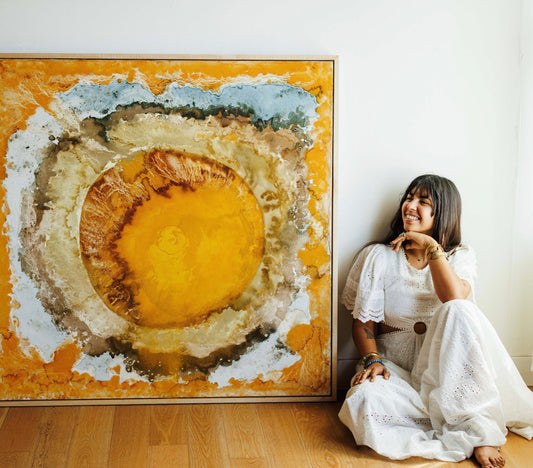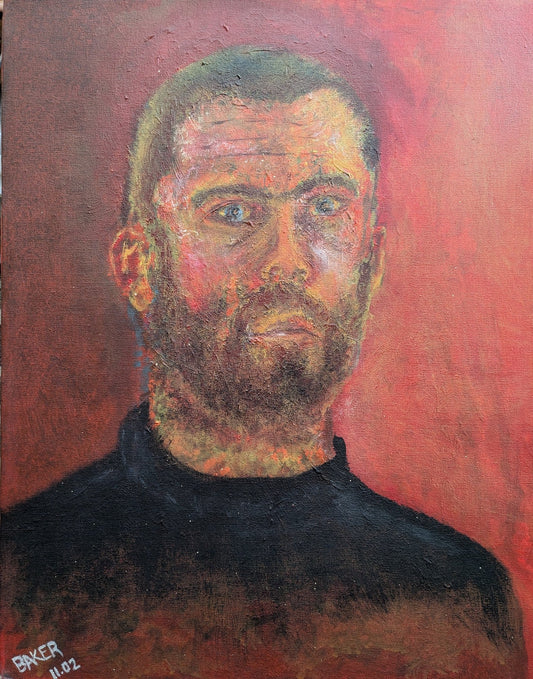Scott Baker
How often do you act on your life’s inspirations? This is a question I found myself asking after learning more about Scott Baker, an artist who gives life to the discarded to be treasured by the world. I found Baker’s work through connecting with the Only Rejected Works Gallery, and his work immediately intrigued me. Art started as his creative expression amid hard-fought battles with his mental health. His art began with poetry, but he began mixing 2D and 3D media as his visions broadened. He uses everything rejected, seeing discarded pieces as an extension of himself. In doing so, the works carry the memories of the discarded items. This blending of 2D and 3D motivated him to learn taxidermy, though he does not usually use it in his works. He believes rejected animals should still have space held for them, even if they didn’t get to experience it much in life.

His process blends the distinctions between 2D and 3D by working to make his canvasses sculptural. Baker starts his process by focusing on a single element he wants to highlight in his work. He investigates its relationships with its environment and how it may interact with other subjects he wants to include in his work. Suppose he’s focusing on toy figures like Barbie dolls or an Action Man. In that case, he might focus on the juxtaposition of humor and sorrow, as these objects are the source of adolescent joy, but when found discarded, they have an element of pity and nostalgia.
Baker’s visions have never led him to focus on creating art with perfection and precision as its basis. “Artistry is not mutually exclusive to a practice but can be focused wherever it chooses,” he said. He never sketches his works, as the ritual of shaping his vision into reality by working alongside his media is often more profound and enjoyable than the final product. His works tell stories of recreation and growth in every canvas corner. Sometimes, he leaves pieces unfinished, returning to them when the time is right and their story can be completed.

“I prefer to leave traces that a very flawed human created the pieces, not a robotic cloning machine,” Baker said. “After the advent of photography in the 1840s, it meant reality could be captured simply, and the only realm left for the artists was to explore the unseen.”
After years of finessing his craft, Baker developed a method to articulate his visions into reality. Baker appreciates the simplicity and clarity of a vision, as too many ideas without direction can muddy a person’s messages. When working with rejected items as media, each piece’s story needs to be clear, or their story risks being rejected for a second time. Much like the objects he uses in his work, he himself is not shaken by dissatisfaction or rejection. While they’ve tested him to his limits, they’ve never broken his love for the arts.

The concept of an artwork having only one message bothers Baker, comparing it to hitting the symbolism into a viewer like a mallet in a whack-a-mole game. “Other people don’t really concern me. They confuse me too much. I’ve never fitted in and given up trying.” Baker said. Baker stands firm in his work; those who can appreciate his process and his story will resonate with it and continue connecting with him, and if not, that is okay. His stance comes from experiences with customers in his taxidermy work, who experience external pressures to return his work. A customer loved a part fox pelt he completed and brought it to her home. However, she later asked to try to return it as an exception to its “no returns” policy because her roommate did not like it at the time. Baker almost gave in to “do the right thing” and amend the situation with her and her roommate. However, he ultimately decided he would not allow her to return to work.
Baker would change nothing if this situation happened again. He creates for himself for telling the stories of the rejected.
“If people don’t like what they see, they cannot be commended for attempting to smash the mirror. The error is in them, not in what they project upon. I am trying to help them see, not keep up the pretense of feigning blindness.”

When thinking back to his career, he recalls a self-portrait he made in 2002. It was his first painting and one of the few figurative works he completed early in his career. He was early in exploring his inspirations, so he gifted the work to his grandparents. At the time, he had not considered becoming an artist. While working on the painting, he experienced the fading out of a relationship and fighting mental health struggles. Later that spring, he entered into a psychotherapy program for an intense nine months. However, as time progressed, his grandparents passed away, and the painting is now back in his possession, holding stories of heartbreak, loss, mental health, and grief.
“It encapsulates the first steps of a very confused young man grasping for meaning and reasons to exist when everything terrified and shattered him, and he did not want to go on living another day,” Baker said.

What’s the future for Scott Baker’s works? Only time will tell. He prefers to find his next steps as they come and let the chips fall where they may. His media and inspiration come from places of spontaneity and uncertainty, so the next steps that are right for him will find him at the right time.
“I can gather ingredients, but I never know until I’ve started it, what recipe I’ll come up with and what flavours the meal will entail,” he said.

To anyone considering joining the art profession, he emphasizes that an artist’s journey is an uphill battle, one of misunderstanding, rejection, and toil. You won’t be in it for the money, but you’ll be in it because your mark on the world will be yours and yours alone, at your own pace and with your own vision.
“I work only to challenge and please myself and maybe scratch out a tiny corner of the universe with my name on.”
©ArtRKL™️ LLC 2021-2024. All rights reserved. This material may not be published, broadcast, rewritten or redistributed. ArtRKL™️ and its underscore design indicate trademarks of ArtRKL™️ LLC and its subsidiaries.





